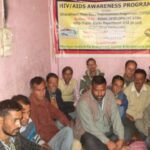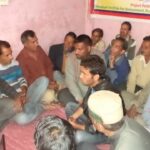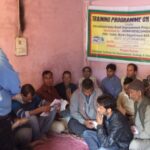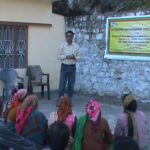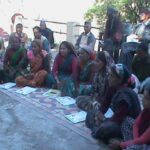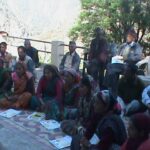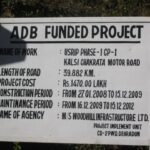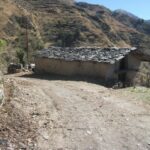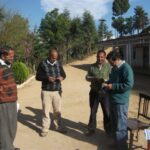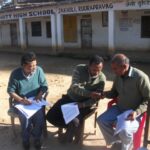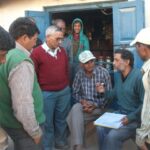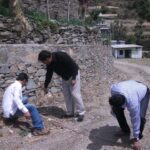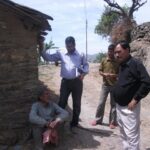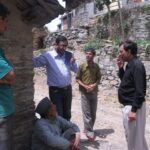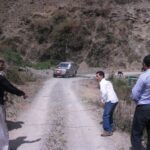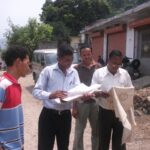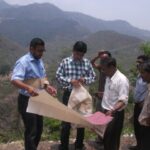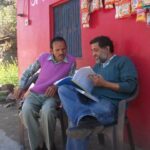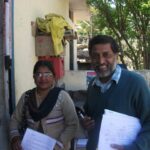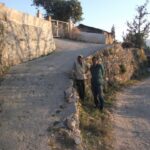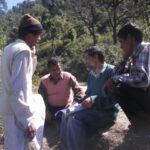REHABILITATION & RESETTLEMENT IMPLEMENTATION PROGRAM UNDER USRIP- III
REHABILITATION & RESETTLEMENT IMPLEMENTATION PROGRAM UNDER UTTARAKHAND STATE ROADS INVESTMENT PROGRAM (USRIP- III)
(ASIAN DEVELOPMENT BANK- ADB ASSISTED PROJECT)
INTRODUCTION AND BACKGROUND OF THE PROJECT
The Uttarakhand State Road Sector Investment Project (USRIP) Phase III is a pivotal initiative by the state government aimed at spurring economic growth and reducing poverty. It places a primary focus on improving connectivity and access to vital social services such as healthcare and education. This undertaking is in direct alignment with the state government’s vision to optimize the effectiveness and efficiency of road sector management. The overarching goal is to empower this sector with the capability to facilitate efficient road investments and deliver sustainable developmental outcomes, thereby further bolstering Uttarakhand’s social and economic progress. At its core, this project represents a substantial government-led effort to nurture economic advancement and poverty alleviation within Uttarakhand. Its fundamental mission is to bolster connectivity and accessibility to essential social services, including healthcare and education, while concurrently enhancing the operational efficiency of the state’s road sector. Additionally, it aims to promote the principles of sustainability in road infrastructure development, with a strong commitment to fostering the broader social and economic development of the region.
This extensive project will be executed through a well-coordinated effort involving two key units, the Project Management Unit (PMU) of ADB-PWD at the state level and a Project Implementation Unit (PIU) of ADB-PWD at the district level. Facilitating this initiative, HIFEED has been entrusted with a pivotal role in implementing five Resettlement Plans within the state. Under the guidance of the Project Management Unit of ADB-PWD, HIFEED shoulders the responsibility of executing the five Resettlement Plans, which are integral to Phase-3 of the ADB-funded project, spanning across the districts of Dehradun, Rudraprayag, and Bageshwar. The central objective here is to enhance road connectivity, thereby bolstering accessibility, alleviating poverty, and generating opportunities for the remote populations of the state. This improvement in road connectivity is expected to not only provide better access to markets but also uplift healthcare and education services in the mountainous regions.
In addition to these vital components, the project places significant emphasis on community participation. It envisions the active engagement of diverse stakeholders within the community, encompassing community leaders, prominent citizens, Community-Based Organizations (CBOs), women, and marginalized groups such as Indigenous communities, scheduled castes, and economically disadvantaged households. A core element of this community engagement strategy involves the organization of focus group discussions (FGDs). These discussions are instrumental in disseminating information, gathering valuable insights, and addressing concerns related to the project’s design, technology choices, safety measures, and other pertinent aspects. The ultimate objective is to ensure inclusive participation, thereby empowering various segments of the community, with particular attention to advancing the role of women.
AIMS AND OBJECTIVES OF THE PROJECT
1. Execute the Resettlement Plans (RPs) for Phase-3 of the ADB-funded project and ensure efficient compensation disbursement to impacted families within a strict nine-month timeline, encompassing the districts of Dehradun, Rudraprayag, and Bageshwar in Uttarakhand.
2. Prioritize and extend substantial support to the Project Implementation Unit (PIU) to facilitate effective RP realization and compensation provision, demonstrating steadfast commitment to achieving milestones across five distinct road sub-projects, thereby reinforcing dedication to the project’s overarching goals in these regions.
3. Undertake a comprehensive analysis of impacts resulting from subproject execution and formulate effective measures to mitigate potential losses by basing the RP on findings from census surveys, field visits, and engagements with displaced persons in the subproject area.
4. Ensure compensation and resettlement assistance for all displaced individuals, irrespective of title holding status, through the utilization of a comprehensive entitlement matrix that addresses compensation for loss of land and crops/trees at replacement value, loss of structures including residential and commercial properties, restoration of income and livelihoods, mitigation of business loss, and compensation for wage loss.
5. Facilitate a smooth transition for displaced families through assistance in shifting and allocate additional support to vulnerable groups, including women-headed households, Scheduled Castes (SC), Scheduled Tribes (ST), Other Backward Classes (OBC), those below the poverty line (BPL), the elderly, and those with disabilities.
6. Initiate efforts to rebuild or restore community assets and facilities as part of the rehabilitation process, ensuring a comprehensive review and validation of progress achieved in RP implementation as outlined in the RP, and employing rigorous monitoring mechanisms to gauge the efficiency and efficacy of the PIU and engaged Non-Governmental Organizations (NGOs) in executing the RPs.
7. Conduct comprehensive assessments to evaluate the extent to which resettlement objectives, particularly related to livelihood restoration and living standards for Displaced Persons (DPs), have been realized, while scrutinizing the effectiveness of the ‘Community Participation Strategy,’ emphasizing engagement of vulnerable groups.
8. Analyze overall resettlement efficiency, effectiveness, impact, and sustainability, providing recommendations for corrective measures if required, and assess the project’s repercussions on Indigenous People and groups, evaluating the efficacy of mitigation measures.
9. Collaborate with an external monitoring agency, specifically a Supervision Consultant, to oversee and evaluate resettlement efforts, and develop precise monitoring indicators tailored to oversee Resettlement Plans.
10. Conduct a comprehensive review of internal monitoring outcomes and provide insights into strengths and weaknesses in implementation, validate the progress made in executing the resettlement strategy for the subproject, generating quarterly reports for stakeholders.
11. Evaluate the adequacy of compensation awarded to DPs and the sufficiency of opportunities for income generation, livelihood improvement, and quality of life enhancement, while assessing the effectiveness and adequacy of consultative processes with affected DPs, emphasizing inclusivity, accessibility of grievance procedures and legal redress mechanisms, and dissemination of information.
COMPONENTS AND ACTIVITIES OF THE PROJECT
1. Initiate a thorough information campaign on Resettlement Entitlement to educate and inform Affected Persons (APs) within affected regions about entitlement policies and procedures.
2. Devise and execute a tailored informative campaign for APs, aiming to clarify entitlement policy and the process of accessing benefits; this includes conducting a public campaign in project areas to share key Resettlement Plan provisions and ensure APs are informed.
3. Undertake AP identification and authentication using data from the resettlement census survey, manage ID card issuance to include identification details, photos, and socio-economic profiles, and retain flexibility to update cards with losses incurred, compensation preferences, and assistance choices.
4. Oversee continuous maintenance and computerization of the APs’ database while simultaneously creating digital files for each AP, streamlining record-keeping and information management.
5. Address AP grievances through community-level discussions facilitated by Panchayat Level Committees, meticulously documenting and resolving concerns to enhance grievance redressal.
6. Play a pivotal role in ensuring eligible individuals receive proper compensation and assistance for livelihood restoration, contributing to a seamless resettlement transition.
7. Facilitate timely disbursement of shifting allowances and compensation to APs prior to relocation, demonstrating dedication to smooth relocation procedures.
8. Provide ongoing education and training, particularly for women and stakeholders, focusing on skill development and diverse community advancement aspects to foster continuous learning.
9. Implement targeted awareness efforts through Focus Group Discussions (FGDs) and corner meetings, sensitizing stakeholders, especially vulnerable groups, to the potential HIV/AIDS threat; highlight the benefits of active involvement in awareness-building initiatives to bolster community engagement.
10. Organize community events involving women, vulnerable groups, and Community-Based Organizations (CBOs) to participate in Awareness Building Components; these comprehensive activities are scheduled post-receipt of necessary resettlement and rehabilitation aid by Displaced Persons (DPs), signifying project culmination.
TARGET AREA OF THE PROJECT
The geographical expanse of the project encompassed the districts of Dehradun, Rudraprayag, and Bageshwar in the state of Uttarakhand. This endeavour was ambitiously designed to encapsulate the development of several vital roadways within these regions. A fundamental aspect of this project involved the acquisition of land from the local communities for the explicit purpose of constructing these roads. As a measure of fair compensation, the government diligently ensured the disbursement of compensation to these communities, acknowledging their contribution to the infrastructural development. The specific roads within this project scope included:
1. Kalsi-BerattKhai Road (Kalsi-BerathKhai Motor Road to Kaha Nehra Unaha Motor Road)
2. SahiyaDamta-Panuwa Motor Road to MalethaDatunuBadnu Motor Road
3. Raitoli-Jasholi Motor Road
4. Mayali-Jakholi Motor Road.
5. Pauri Bend-Magnesite Factory Road (Parlichina-Magnesite Factory Motor Road)
TARGET GROUPS AND BENEFICIARIES OF THE PROJECT
The project was designed with a specific focus on a particular target group, which was the local community whose land had been acquired by the government for the purpose of constructing roads. The primary objective of this initiative was to ensure that the members of this community were adequately compensated for the loss of their land.
FUNDING PARTNER OF THE PROJECT
The funding for the project was provided by the Project Management Unit (PMU) of the Public Works Department, Government of Uttarakhand, Dehradun, with financial backing from the Asian Development Bank (ADB).
SANCTIONED BUDGET OF THE PROJECT
The budget for the assignment was approved by ADB-PWD through a sanction order (No. 988/27 PMU Transport-Uttarakhand/12) dated September 22, 2012. The total cost of the assignment, which spanned nine months, was Rs. 4,60,000.00 as sanctioned by ADB-PWD.
OUTCOMES AND ACHIEVEMENTS OF THE PROJECT
The successful implementation of the Rehabilitation & Resettlement Implementation Program has resulted in the following outcomes and achievements:
1. All five Resettlement Plans in Phase- 3 of the ADB-funded project across three districts have been successfully implemented, resulting in improved road connectivity and accessibility in the region.
2. HIFEED staff have performed several key tasks and activities, including conducting an information campaign on Resettlement Entitlement, identifying APs, issuing ID cards, updating the APs database, and creating/computerizing affected person’s files.
3. HIFEED has addressed AP grievances through community-level discussions and interactions with individuals at the household level, and has held meetings with individual households alongside ADB-PWD staff at the Project Implementation Unit (PIU) level.
4. Training workshops have been held in villages where roads are being expanded, involving village youth to ensure that no DPs are losing their livelihood due to the implementation of the resettlement plans (RPs).
5. HIV/AIDS awareness activities have been conducted by HIFEED in the project location, utilizing its experience and software as a previously engaged partner of the Uttarakhand State AIDS Control Organization (USACS).


